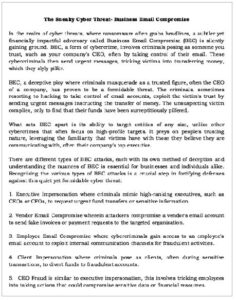In the realm of cyber threats, where ransomware often grabs headlines, a subtler yet financially impactful adversary called Business Email Compromise (BEC) is silently gaining ground. BEC, a form of cybercrime, involves criminals posing as someone you trust, such as your company’s CEO, often by taking control of their email. These cybercriminals then send urgent messages, tricking victims into transferring money, which they slyly pilfer.
BEC, a deceptive ploy where criminals masquerade as a trusted figure, often the CEO of a company, has proven to be a formidable threat. The criminals, sometimes resorting to hacking to take control of email accounts, exploit the victim’s trust by sending urgent messages instructing the transfer of money. The unsuspecting victim complies, only to find that their funds have been surreptitiously pilfered.
What sets BEC apart is its ability to target entities of any size, unlike other cybercrimes that often focus on high-profile targets. It preys on people’s trusting nature, leveraging the familiarity that victims have with those they believe they are communicating with, often their company’s top executive.
There are different types of BEC attacks, each with its own method of deception and understanding the nuances of BEC is essential for businesses and individuals alike. Recognizing the various types of BEC attacks is a crucial step in fortifying defenses against this quiet yet formidable cyber threat:
1. Executive Impersonation where criminals mimic high-ranking executives, such as CEOs or CFOs, to request urgent fund transfers or sensitive information.
2. Vendor Email Compromise wherein attackers compromise a vendor’s email account to send fake invoices or payment requests to the targeted organization.
3. Employee Email Compromise where cybercriminals gain access to an employee’s email account to exploit internal communication channels for fraudulent activities.
4. Client Impersonation where criminals pose as clients, often during sensitive transactions, to divert funds to fraudulent accounts.
5. CEO Fraud is similar to executive impersonation, this involves tricking employees into taking actions that could compromise sensitive data or financial resources.
The financial toll of BEC is staggering, accounting for billions in losses. Moreover, its stealthy nature contributes to its growing prevalence. Victims are often unaware of the breach until much later, allowing the criminals to escape scrutiny for an extended period.
BEC operates in the shadows, not garnering the same attention as ransomware, and there are notable reasons for this. Unlike ransomware, BEC isn’t destructive in a visible way. It doesn’t shut down hospital systems or pose an immediate national security threat, making it less likely to capture public and media attention.
Moreover, BEC lacks the technical intrigue that might attract security researchers and headline-worthy presentations at high-profile cyber conferences. It operates discreetly, akin to a silent infiltrator rather than a flashy attacker, making it less likely to be discussed in the realms of cybersecurity research and expertise.
The “death by 1,000 papercuts” effect is another reason BEC often flies under the radar. While individual heists may be smaller, the cumulative impact over time is substantial. Yet, the incremental nature of these attacks means they are less likely to make news headlines.
In conclusion, as ransomware continues to dominate cybersecurity discussions, the quiet ascent of BEC demands equal consideration.
Its financial impact is colossal, and its ability to operate below the radar, targeting entities of all sizes, poses a significant threat. As we navigate the evolving landscape of cyber threats, it is essential to recognize and address the nuanced dangers posed by BEC to safeguard businesses and individuals from its discreet but formidable influence.
(Khushbu Jain is a practicing advocate in the Supreme Court and founding partner of the law firm, Ark Legal. She can be contacted on X: @ advocatekhushbu.)
























